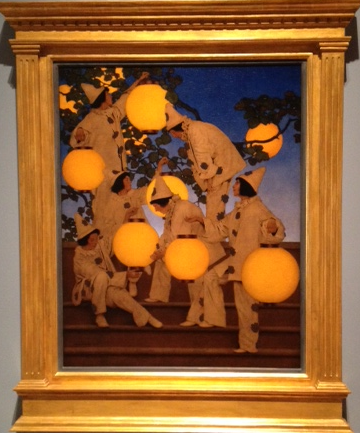The frames on many of the works of art in Crystal Bridges’ collection are of as much interest to visitors as the artworks themselves. Gallery Guides are frequently asked where the frames come from, how old they are, or if they are original. It’s not surprising–many of the frames on the nineteenth-century works are ornamental confections, elaborately carved and gilded. Many are antique works of art in and of themselves, some more than 200 years old.
It goes without saying that a frame is an important element in the overall experience of viewing a work of art. A beautiful frame can enhance the sense of a painting’s grandeur, or complement its particular style. A well-considered frame can also serve to enhance the viewer’s experience. The large, multi-layered frames that grace the Museum’s Hudson River School landscapes, for example, were favored by the artists as a means of drawing the viewer into the painting, they help enhance the sense of depth, to make you feel as if you’re looking through a window.

A grouping of artworks by Hudson River School artists in Crystal Bridges Early Nineteenth-Century Art Gallery show the multi-level frames favored by these landscape artists to enhance the viewer’s perspective.
Many artists over the centuries have taken pains in choosing the style of frame in which their works were exhibited, and for this reason, Crystal Bridges curators take equal pains with the selection of frames for its collection.
Most paintings are acquired with a frame, ideally the original one chosen for it by the artist or first owner. If not original, the frame should at least be contemporary with the work itself. A frame that is much older or much younger than the painting it showcases can compromise the work’s overall integrity as an object. It can also clash in style with the painting itself, causing a sort of visual dissonance for the viewer.
If the frame accompanying a work of art is inappropriate, curators have a couple of options. They can try to find a frame of the correct time period and style, or they can purchase a reproduction. Either way, it devolves to the curators to find a frame that matches, as closely as possible, the look of the original frame for the work.
Determining what that means can require some academic sleuth work. For some artists, frame choices are relatively simple. Winslow Homer, for example, preferred a particular molding, and used it on almost all of his works. If the choices are not so clear-cut, the curators might look for a museum that has a work by the same artist in its original frame, and use that frame as a reference. Presumably, a work by the same artist created at around the same time would have been framed in a similar style. If, however, no such original is known to exist, more in-depth research is required. Curators might look for photographs or other images of exhibitions featuring the artist’s work, or images of the artist’s’studio, to see what style of frames were preferred. They might also read descriptions of the artist’s studio or of specific works written by contemporaries that include allusions to the frames.
Once the curators have a good idea of what style of frame is needed, it’s time to go about finding and acquiring an actual frame—not an easy thing to do if the frame in question is one hundred years old or more. Just like today, fashions in household decor changed during the 19th and early twentieth centuries. Frame styles, like styles in furniture or drapery, came and went. Sadly, many of the highly ornate and gilded frames from the early part of the nineteenth century were discarded as “fussy” and old-fashioned during the forward-looking 1920s and after. Fortunately however, some of those discards have found their way into the hands of antiques dealers, some of whom have made a career of finding and refurbishing antique frames. The downside: these can be very expensive. A well-preserved eighteenth- or nineteenth-century frame can be priced in the tens of thousands of dollars.
If a period frame is unavailable or the cost is prohibitive, a reproduction frame, made from a mold of an original from the appropriate period, is also an option. When selecting reproductions, there are many more molding options available. Curators send the framers a photo of the work in question, and the framers return images of the work surrounded by various period-appropriate moldings, so curators can decide which looks best. A new frame can give a work of art a new lease on life. Take, for example, Parrish’s The Lantern Bearers. It was first exhibited in the frame that came with the work when it was acquired, but the frame really didn’t do the work justice.
Curators chose a frame with a bright gold finish that complements the brilliant gold hues in the painting, and a molding that resembles a theatrical proscenium, providing a perfect context for a painting featuring theatrical characters and has such a theatrical composition. The freshly framed work was so striking, in fact, that it warranted a new position in the galleries. It now has pride of place as the lone artwork on a short wall in the Late Nineteenth-Century Art Gallery.
Over the long lifetime of a work of art, frames can be damaged or altered. When a painting is acquired with its original frame, the frame sometimes requires repair or restoration before it’s ready to be exhibited. In the Crystal Bridges collection, one frame in particular has undergone a lengthy restoration process: the gilt frame on Thomas Eakins’s portrait of Benjamin Rand, on view in the Late Nineteenth-Century Art Gallery. But that’s a story for another post. Stay tuned!






